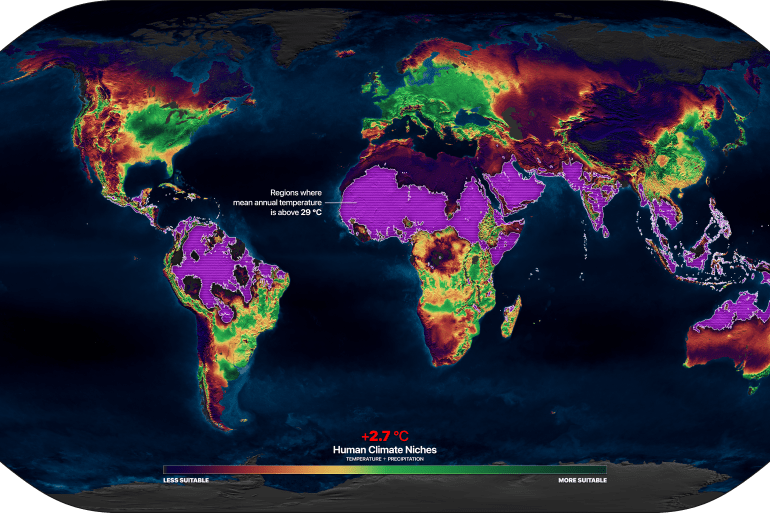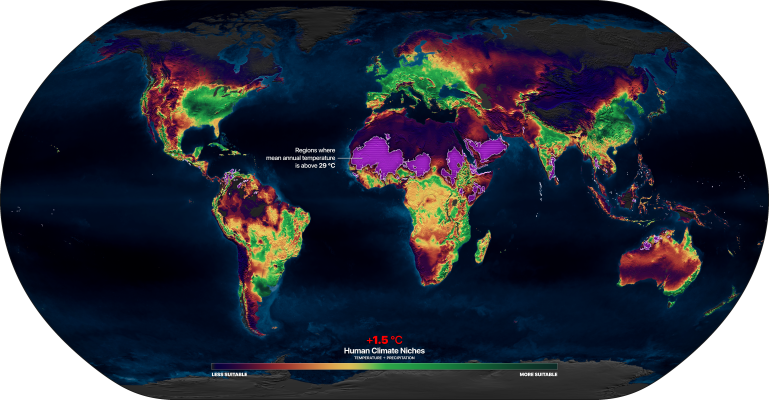Middle East countries face extreme heat risk, study finds
New research published in Nature Sustainability journal suggests several regional countries may have entire populations exposed to extreme temperatures due to climate change.

Countries across the Gulf region and the wider Middle East are highly vulnerable to extreme heat borne out of climate change, with poorer populations being particularly at risk in the decades ahead, a new study has warned.
The research, published in the Nature Sustainability journal and released on Monday, looks at how countries are exposed to “unprecedented heat” that it describes as mean annual temperatures of 29 degrees Celsius (84.2 degrees Fahrenheit) or higher.
Keep reading
list of 4 itemsConflict-hit Arab countries miss out on climate funds: Aid groups
Are militaries driving the climate crisis?
Climate talks see push for deadline on ending ‘fossil fuel age’
It evaluates the exposure in two scenarios by 2070, namely if global temperatures rise by 1.5C (2.7F) or by 2.7C (4.9F).
In a scenario where the global population is 9.5 billion people and global temperatures rise by 2.7C (4.9F) by that time, Qatar would have the entirety of its population exposed to extreme heat, closely followed by the United Arab Emirates (UAE) and Bahrain with almost their whole populations exposed, the study found.
Kuwait and Oman would have more than 80 percent of their populations exposed, followed by Saudi Arabia with more than 60 percent and Yemen with about half.
Saudi Arabia and the UAE may be facing a dire situation in either temperature rise scenario as a majority of their populations are also projected to be exposed to extreme heat even if global temperatures rise by 1.5C (2.7F).
While faring relatively better, other countries in the Middle East are not completely safe either, and are expected to experience some levels of high median heat.
Iran, for instance, is cooler on the exposure map, but is still expected to have close to four million people vulnerable.
Last week, the World Meteorological Organization said the next five years will be the warmest period ever recorded as for the first time, global temperatures were now more likely than not to exceed 1.5C (2.7F) of warming until 2027.

‘Habitability challenges’
Tim Lenton, one of the chief authors of the study, said the Middle East is an already hot region that is expected to face widespread extreme heat in the future.
“This will pose habitability challenges of coping physiologically with extreme heat, producing food, sourcing water, and working outside. These challenges already exist, meaning that adaptation strategies are at least partly already in place,” the professor of climate change at the University of Exeter told Al Jazeera.
According to Lenton, how wealthy a nation is can play a part in how vulnerable it will be. Poorer populations will face a greater risk, with the elderly and the very young, as well as pregnant women and people with illnesses being particularly vulnerable.
“So it is the poorer countries where the greatest risks tend to arise,” Lenton said. “But the rich cannot completely isolate themselves from the impacts of extreme heat even if they have air-conditioned buildings [and] vehicles.”
Muammer Koç, a professor of sustainable development at Qatar’s Hamad Bin Khalifa University, said he agrees with the findings of the study and others similar to it that have predicted extreme weather exposures as a result of global warming.
He told Al Jazeera that like many other places across the globe, the Middle East can also expect rising levels of temperature, heat, humidity and seas that will worsen living conditions.
This, he said, could make certain regions, including parts of the Middle East, unlivable for several months of the year, also leading to the deaths of humans and animals that are crucial to the environment.
“Such impacts are expected to cause further calamity, damages and risks on the infrastructure such as roadways, railways, water and electricity supply network as well as increased burdens and limited accessibility on the healthcare facilities,” Koç said.
The professor said countries across the Gulf and the wider Middle East, as well as the South West Asia region, including Pakistan and India, must enhance cooperation to tackle the effects of climate change.
“There is no other way to fully mitigate and prepare for responding to such mega catastrophic events timely, completely and at low costs,” he said.